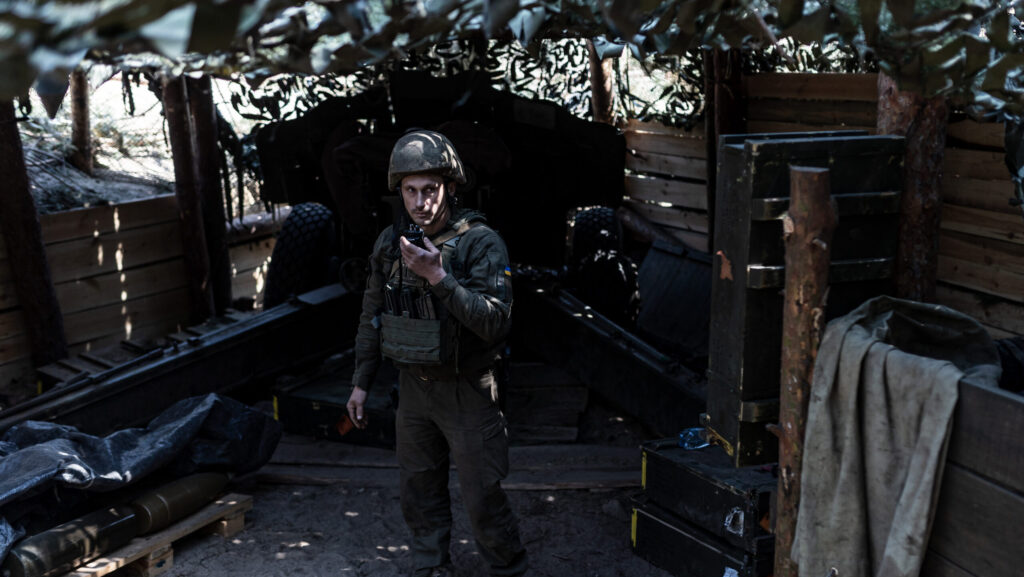A Ukrainian soldier of the Khartia Brigade, a military unit of Ukrainian National Guard, speaks by radio next to D-20 artillery towards the direction of Kupiansk, at his position in Donetsk Oblast, Ukraine on May 5, 2024. (Photo by Diego Herrera Carcedo/Anadolu via Getty Images)
The ongoing war in Ukraine offers a modern-day case study of a fight for battlefield communication in an engagement between mismatched military powers. No technological slouch, Ukraine is still outgunned by Russia’s long-established defense industrial base and its quantitative advantage in electronic warfare.
Kyiv, therefore, should consider going further than it already has with more cost-effective communication solutions rather than trying to match Russia on the EW battlefield.
Since the introduction of the first two-way radios, militaries have become increasingly dependent on the electromagnetic spectrum (EMS) rather than physical cables for their communications. Almost immediately, adversaries worked to impede the use of this new domain through countermeasures such as inserting false signals on the same frequency or the more morbid approach of targeting radiomen. These developments kicked off the move-countermove competition in electronic warfare (EW), which continues to this day.
Modern military operations are highly reliant on access to the EMS for communications, navigation, and to conduct overall command and control (C2). In response, near-peer competitors have invested in methods to deny use of the EMS to their adversaries. Competing with leading military powers in this rapidly developing technological space requires a high level of investment, intelligence collection of adversary capabilities, and innovation.
This approach may not be feasible, or desired, for a nation like Ukraine that has a tighter defense budget than its larger antagonist.
For a smaller military power under the shadow of a regional aggressor it may instead be more beneficial to leverage past communications techniques to sidestep EW attacks aimed at disabling EMS systems. Using legacy communications tactics can be less costly than developing a robust, resilient and secure wireless architecture in a highly contested environment. Furthermore, by reducing reliance on the EMS for friendly wireless communications a military can attempt “spectrum denial” at the frontline, jamming across radio frequencies without fear of disrupting its own communication.
In the opening of the 2022 Russian invasion of Ukraine, Russian forces used EW at all levels to target Ukrainian air defenses and radio communications. However, after Russia’s aggression in 2014, these tactics were largely anticipated. Ukraine was less dependent on the EMS for tactical communications and readily able to shift to historical methods including runners and dispatch drivers.
In contrast, Russia suffered heavily from their own jamming which impacted their ability to command the battlefield. Although detrimental to both sides, EMS denial proved to have an outsized impact on the attacking force with a higher reliance on technology. Realizing this, after the first week of conflict Russia elected to relax the suppression of Ukrainian radar and communications. While EW superiority would be preferable, Ukraine demonstrated how a reduced reliance on the EMS, among other factors, mitigated Russia’s sizable EW advantage in the opening stage of the invasion.
A tactical hardwired network is another example of a legacy technique that could be leveraged in a contested electromagnetic environment. Wired networks cannot be jammed by adversary interference and require physically tapping to intercept signals. Spiral bound cables can be reeled out rapidly and have been utilized in previous conflicts to communicate over thousands of kilometers. Modern, purpose-built vehicles such as cable trucks could further increase the speed of creating vast wire networks.
This approach is particularly useful for static defensive lines that can be identified prior to, or at the outset of, conflict. While wires can be physically cut by kinetic action, parallel paths can create redundancy. In the worst-case, as demonstrated in Ukraine, runners and drivers can be leveraged for the last tactical mile of communications.
One downside to this approach may be that wired networks could lead adversary reconnaissance platforms to C2 hubs. In response to this risk, decoy lines and hubs could be created to obfuscate the location of real targets. And while adversaries could search for physical wires, modern signals intelligence and direction-finding techniques can detect and locate electromagnetic emissions from C2 hubs that rely on the EMS potentially even faster.
Other nations could also choose to conceal their tactical communications underground to increase resilience. While new construction would be more time consuming and costly, many locations already have pre-existing subterranean infrastructure that could be leveraged.
For example, Taipei City, the capital of Taiwan, has over 100 kilometers of earthquake resistant metro lines. This partially underground metro encompasses over 100 stations arranged in a hub and spoke pattern with redundant central lines. Metro systems like this could be leveraged to create a robust and resilient C2 system that is highly defensible from jamming, signal interception, and kinetic attack.
Balancing legacy techniques, modern technology, and pre-existing infrastructure in this way may offer a more cost-effective approach to resilient communications for a military operating within a heavily contested EMS. When it comes to battlefield communications resilience, Ukraine is demonstrating that sometimes vintage systems and techniques can provide militaries with simpler and cheaper alternatives to keep critical lines of communication open.
Nicholas Johnson is a senior technical analyst at the nonprofit, RAND, the nonpartisan research institution. With a background in the United States Navy and as a combat system test engineer, his current research at RAND includes missile defense, electromagnetic warfare, naval warfare, and wargaming.











